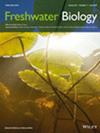Norfloxacin Pollution Reshapes Interspecific Relationships in Zooplankton: Impacts of Reduced Phytoplankton Defence and Altered Zooplankton Motility Across Individual, Population and Community Scales
IF 2.7
2区 生物学
Q2 ECOLOGY
引用次数: 0
Abstract
- Recent studies indicate that antibiotics can inhibit the formation of phytoplankton colonies. This may affect zooplankton of varying sizes differently, potentially altering interspecific competition.
- To investigate these effects, we established resource (predator-free) and apparent competition (with a larval damselfly as predator) systems by co-culturing Daphnia magna and Moina affinis with the algae Scenedesmus quadricauda as food. We examined the effects of norfloxacin (NOR, 0, 31.25, 500 and 8000 μg L−1) on the colony formation of S. quadricauda and on both individual- and population-level traits of zooplankton, along with interspecific competitive dynamics.
- NOR impaired the ability of S. quadricauda to form large colonies, increasing grazing rates and boosting population expansion of both grazer species, particularly enhancing the competitive advantage of the smaller species, M. affinis, in the resource competition system. However, NOR caused oxidative damage and reduced mobility, which impacted M. affinis more severely, increasing its predation risk by damselfly larvae and reducing its dominance in the apparent competition system.
- Our findings indicate that zooplankton interspecies competition is highly sensitive to antibiotic contamination. Moreover, the combined effects of differences in individual body size and sensitivity determine the potential hazards antibiotics pose to zooplankton communities, highlighting the need for concern.
诺氟沙星污染重塑浮游动物种间关系:个体、种群和群落尺度上浮游植物防御能力降低和浮游动物运动改变的影响
最近的研究表明,抗生素可以抑制浮游植物菌落的形成。这可能会对不同大小的浮游动物产生不同的影响,潜在地改变种间竞争。为了研究这些效应,我们建立了资源(无捕食者)和明显竞争(以豆娘幼虫为捕食者)系统,将大水蚤和亲缘水蚤与四角藻(Scenedesmus quadricauda)作为食物共培养。研究了诺氟沙星(NOR、0、31.25、500和8000 μg L−1)对圆尾螺(S. quadricauda)群落形成、浮游动物个体和种群水平性状以及种间竞争动态的影响。NOR损害了四足沙鼠形成大群体的能力,增加了两种食草动物的放牧率,促进了种群的扩张,特别是增强了较小的物种类群在资源竞争系统中的竞争优势。然而,NOR引起的氧化损伤和迁移能力降低对豆娘蛾的影响更为严重,增加了豆娘幼虫的捕食风险,降低了其在表观竞争系统中的优势地位。研究结果表明,浮游动物种间竞争对抗生素污染高度敏感。此外,个体体型和敏感性差异的综合影响决定了抗生素对浮游动物群落的潜在危害,突出了需要关注的问题。
本文章由计算机程序翻译,如有差异,请以英文原文为准。
求助全文
约1分钟内获得全文
求助全文
来源期刊

Freshwater Biology
生物-海洋与淡水生物学
CiteScore
5.90
自引率
3.70%
发文量
162
审稿时长
2 months
期刊介绍:
Freshwater Biology publishes papers on all aspects of the ecology of inland waters, including rivers and lakes, ground waters, flood plains and other freshwater wetlands. We include studies of micro-organisms, algae, macrophytes, invertebrates, fish and other vertebrates, as well as those concerning whole systems and related physical and chemical aspects of the environment, provided that they have clear biological relevance.
Studies may focus at any level in the ecological hierarchy from physiological ecology and animal behaviour, through population dynamics and evolutionary genetics, to community interactions, biogeography and ecosystem functioning. They may also be at any scale: from microhabitat to landscape, and continental to global. Preference is given to research, whether meta-analytical, experimental, theoretical or descriptive, highlighting causal (ecological) mechanisms from which clearly stated hypotheses are derived. Manuscripts with an experimental or conceptual flavour are particularly welcome, as are those or which integrate laboratory and field work, and studies from less well researched areas of the world. Priority is given to submissions that are likely to interest a wide range of readers.
We encourage submission of papers well grounded in ecological theory that deal with issues related to the conservation and management of inland waters. Papers interpreting fundamental research in a way that makes clear its applied, strategic or socio-economic relevance are also welcome.
Review articles (FRESHWATER BIOLOGY REVIEWS) and discussion papers (OPINION) are also invited: these enable authors to publish high-quality material outside the constraints of standard research papers.
 求助内容:
求助内容: 应助结果提醒方式:
应助结果提醒方式:


